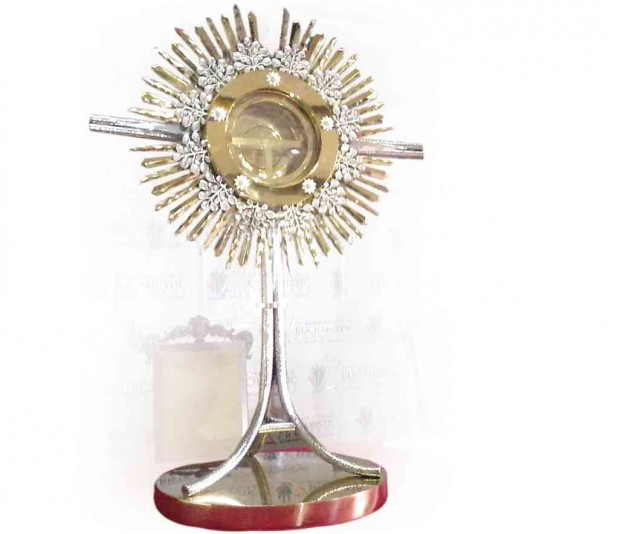Cebu a ‘miracle venue’ for eucharistic confab

A custom-made monstrance (receptacle for consecrated Host), to be used for the IEC, is presented to media. ADOR VINCENT S. MAYOL
Julieta Herrera could have used the money to pay her family’s utility bills. But the 58-year-old woman from Quezon City chose to spend her P8,800 for what she considered more important—attending the 51st International Eucharistic Congress (IEC) here.
“The bills can wait,” she told the Inquirer in a phone interview. “There’s that desire to know more about the Eucharist. That is just so important to me. I wouldn’t mind spending that amount.”
At least 15,000 delegates from all over the world are expected to attend the IEC on Jan. 24-31. The congress takes place every four years to promote awareness of the role that the Eucharist plays in every Catholic’s life, its place in the Catholic Church, the social dimension of the sacraments and the liturgy.
The last time the IEC was held in the Philippines was in 1937 in Manila.
“This is once in a lifetime—my first and last. I want to broaden my knowledge about the Eucharist which is the highest form of prayer. A day without attending Mass makes me feel so empty,” Herrera said.
Article continues after this advertisementHer registration fee and travel expenses were paid by Holy Trinity Parish in Quezon City, where she serves as lector and member of the Legion of Mary.
Article continues after this advertisementBut she has to shoulder the cost for hotel accommodation in Cebu. While she planned to skip the first four days of the meeting due to her work as an employee of the Supreme Court, she could not wait to be part of a historic event.
P550-M pavilion
Cebu Archbishop Jose Palma considers hosting the IEC a blessing from God. “Early on, I felt so anxious because the city had no venue that could seat all 15,000 delegates. But don’t look now, Cebu did a miracle,” he said.
A contractor, Duros Development Corp. (DDC), built the three-story Eucharistic Pavilion at an estimated cost of P550 million on a 25,754-square-meter lot behind the archdiocesan seminary in Barangay Mabolo. The Archdiocese of Cebu did not spend a single centavo.
Under a memorandum of agreement, DDC pledged to donate the entire pavilion. In exchange, the local church will give the company usufruct rights over a 2-hectare lot inside the seminary compound for 25 years.
This would be the first time in the history of the IEC that all the lectures would be held in one venue.
As of mid-December, 8,500 people have registered for the event. About 1,200 of them come from nearly 60 countries.
Church officials are now on the final stage of preparations, focusing on security arrangements, said Cebu Auxiliary Bishop Dennis Villarojo, the 51st IEC secretary general.
Executive Secretary Pacquito Ochoa Jr. has adopted security measures similar to those carried out when Metro Manila hosted the Asia-Pacific Economic Cooperation summit in Manila in November.
Congress concerns
The Eucharist’s importance is attached to Jesus and his sacrifice to save mankind, Villarojo said. The congress would address many concerns—violence, terrorism, hatred, secularization, environmental degradation and poverty.
“All of these are actually interrelated,” Villarojo said. “They all point to the absence of God in the individuals’ lives and in society.”
While the Eucharist is openly celebrated in the Philippines, Villarojo said it was not the case in other countries.
“We, in the Philippines, have always taken for granted that the Catholic faith is at the center of society,” he said. “But there are people who will be coming to this congress who can recount experiences of the faith where they are largely marginalized, and this can be a source of inspiration for us.”
The IEC, he said, would help Catholics realize the value of the Mass and the challenges some people from abroad experience just to celebrate the sacrament.
International speakers have been lined up to best explain the mystery of the Eucharist as well as its social dimensions.
Among them are Timothy Cardinal Dolan of New York, Fr. Timothy Radcliffe, Fr. Francis Maloney, Bishop Robert Barron, Manila Archbishop Luis Antonio Cardinal Tagle, Cotabato Archbishop Orlando Cardinal Quevedo, and Filipino woman lay speaker Dr. Josefina Manabat.
“These are world-renowned speakers and many people have been inspired by their testimonies and talks. So this is one rare occasion where we had gathered these speakers in one setting and it may not happen again anywhere in the world,” Villarojo said.
Philippine culture
Aside from the talks at the pavilion, the delegates will also experience a taste of Philippine culture through various shows at the parishes and other off-site events.
“We can show the world the richness of our culture, the faith of our people, and the traditions of the Filipinos. And we can tell them we have something to share to the world, and likewise as the world comes, we can also learn from them, and be enriched by this encounter of cultures,” Villarojo said.
The 51st IEC opens with a 4 p.m. Mass at Plaza Independencia on Jan. 24, Sunday. Sessions at the Eucharistic Pavilion will begin the following day until Jan. 30.
In the afternoon of Jan. 27, the delegates will be relegated to different parishes in the cities of Cebu and Mandaue for dinner and cultural shows.
The next day, after the sessions, they will visit seven churches in Cebu City for the traditional visita iglesia to pay homage to the Blessed Sacrament. About 5,000 young people will gather in Lapu-Lapu for the IEC Youth Day.
On Jan. 29, Friday, a Mass will be celebrated outside the Cebu Provincial Capitol, followed by a 3.5-kilometer prayer walk to bring the Blessed Sacrament to Plaza Independencia.